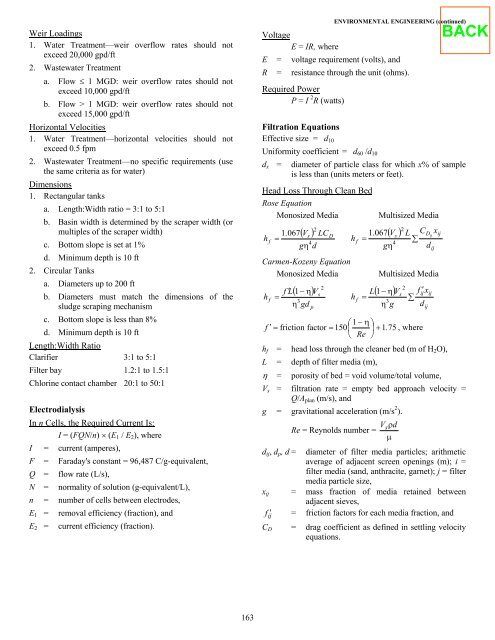fundamentals of engineering supplied-reference handbook - Ventech!
fundamentals of engineering supplied-reference handbook - Ventech!
fundamentals of engineering supplied-reference handbook - Ventech!
You also want an ePaper? Increase the reach of your titles
YUMPU automatically turns print PDFs into web optimized ePapers that Google loves.
Weir Loadings<br />
1. Water Treatment—weir overflow rates should not<br />
exceed 20,000 gpd/ft<br />
2. Wastewater Treatment<br />
a. Flow ≤ 1 MGD: weir overflow rates should not<br />
exceed 10,000 gpd/ft<br />
b. Flow > 1 MGD: weir overflow rates should not<br />
exceed 15,000 gpd/ft<br />
Horizontal Velocities<br />
1. Water Treatment—horizontal velocities should not<br />
exceed 0.5 fpm<br />
2. Wastewater Treatment—no specific requirements (use<br />
the same criteria as for water)<br />
Dimensions<br />
1. Rectangular tanks<br />
a. Length:Width ratio = 3:1 to 5:1<br />
b. Basin width is determined by the scraper width (or<br />
multiples <strong>of</strong> the scraper width)<br />
c. Bottom slope is set at 1%<br />
d. Minimum depth is 10 ft<br />
2. Circular Tanks<br />
a. Diameters up to 200 ft<br />
b. Diameters must match the dimensions <strong>of</strong> the<br />
sludge scraping mechanism<br />
c. Bottom slope is less than 8%<br />
d. Minimum depth is 10 ft<br />
Length:Width Ratio<br />
Clarifier 3:1 to 5:1<br />
Filter bay 1.2:1 to 1.5:1<br />
Chlorine contact chamber 20:1 to 50:1<br />
Electrodialysis<br />
In n Cells, the Required Current Is:<br />
I = (FQN/n) × (E1 / E2), where<br />
I = current (amperes),<br />
F = Faraday's constant = 96,487 C/g-equivalent,<br />
Q = flow rate (L/s),<br />
N = normality <strong>of</strong> solution (g-equivalent/L),<br />
n = number <strong>of</strong> cells between electrodes,<br />
E1 = removal efficiency (fraction), and<br />
E2 = current efficiency (fraction).<br />
163<br />
ENVIRONMENTAL ENGINEERING (continued)<br />
Voltage<br />
E = IR, where<br />
E = voltage requirement (volts), and<br />
R = resistance through the unit (ohms).<br />
Required Power<br />
P = I 2 R (watts)<br />
Filtration Equations<br />
Effective size = d10<br />
Uniformity coefficient = d60 /d10<br />
dx = diameter <strong>of</strong> particle class for which x% <strong>of</strong> sample<br />
is less than (units meters or feet).<br />
Head Loss Through Clean Bed<br />
Rose Equation<br />
Monosized Media Multisized Media<br />
h<br />
( V )<br />
1.<br />
067 s LC<br />
=<br />
gη<br />
d<br />
f 4<br />
2<br />
D<br />
h<br />
f<br />
1.<br />
067<br />
=<br />
gη<br />
2 ( Vs<br />
) L<br />
∑<br />
4<br />
CD<br />
x<br />
ij<br />
d<br />
Carmen-Kozeny Equation<br />
Monosized Media Multisized Media<br />
h<br />
f<br />
( 1−<br />
η)<br />
p<br />
2<br />
s<br />
f L′<br />
V<br />
=<br />
3<br />
η gd<br />
h<br />
f<br />
L<br />
=<br />
( 1−<br />
η)<br />
V<br />
3<br />
η g<br />
2<br />
s<br />
∑ ′ fij<br />
x<br />
d<br />
⎛1 − η ⎞<br />
f ′ = friction factor = 150⎜<br />
⎟ + 1.<br />
75 , where<br />
⎝ Re ⎠<br />
hf = head loss through the cleaner bed (m <strong>of</strong> H2O),<br />
L = depth <strong>of</strong> filter media (m),<br />
η = porosity <strong>of</strong> bed = void volume/total volume,<br />
Vs = filtration rate = empty bed approach velocity =<br />
Q/Aplan (m/s), and<br />
g = gravitational acceleration (m/s 2 ).<br />
Vs ρd<br />
Re = Reynolds number =<br />
µ<br />
dij, dp, d = diameter <strong>of</strong> filter media particles; arithmetic<br />
average <strong>of</strong> adjacent screen openings (m); i =<br />
filter media (sand, anthracite, garnet); j = filter<br />
media particle size,<br />
xij = mass fraction <strong>of</strong> media retained between<br />
adjacent sieves,<br />
f ′ = friction factors for each media fraction, and<br />
ij<br />
CD = drag coefficient as defined in settling velocity<br />
equations.<br />
ij<br />
ij<br />
ij<br />
ij
















